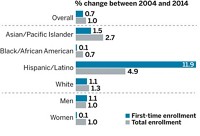Advertisement
Grab your lab coat. Let's get started
Welcome!
Welcome!
Create an account below to get 6 C&EN articles per month, receive newsletters and more - all free.
It seems this is your first time logging in online. Please enter the following information to continue.
As an ACS member you automatically get access to this site. All we need is few more details to create your reading experience.
Not you? Sign in with a different account.
Not you? Sign in with a different account.
ERROR 1
ERROR 1
ERROR 2
ERROR 2
ERROR 2
ERROR 2
ERROR 2
Password and Confirm password must match.
If you have an ACS member number, please enter it here so we can link this account to your membership. (optional)
ERROR 2
ACS values your privacy. By submitting your information, you are gaining access to C&EN and subscribing to our weekly newsletter. We use the information you provide to make your reading experience better, and we will never sell your data to third party members.
Careers
Diversity In Perspective
September 15, 2014
| A version of this story appeared in
Volume 92, Issue 37
As a retired faculty member (1963–2003) of Howard University, the American institution that has graduated the largest number of Ph.D.s of African ancestry (from the U.S., the Caribbean, and Africa), I was interested in two recent articles about diversity among chemistry faculties.
The first states that four prestigious universities in California have partnered to “boost the number of underrepresented minorities in faculty positions” (C&EN, May 5, page 31). And Rigoberto Hernandez writes about “the high degree to which the link between diversity and excellence has been embraced throughout ACS” (C&EN, July 14, page 45).
Howard, which is the leading historically black university, must have the most diverse chemistry faculty of any doctoral institution in the nation. There have been members who were born in every continent except South America, but including Oceania and the Caribbean. In contrast to the words of Hernandez, however, despite their coming “from very different backgrounds,” they do not have “different points of view” based on their origins.
Certainly, chemistry does not show ethnic differences: If you did not know my colleagues’ race, you could not learn it from their chemical publications. In the many department faculty meetings I attended for 40 years, I never observed any divisions along racial lines. We all had Ph.D. degrees and/or postdoctoral training from excellent departments, including the four California universities, and the same ideas about teaching and research.
What I find difficult to understand is the “link between diversity and excellence” that Hernandez suggests in his Comment. Howard, as noted previously, has the most diversity: Does that mean it has an excellent chemistry department? The California universities do not have diverse faculties (at Berkeley, out of 50 faculty members, one is African American and two are Latinos), but they do have a large number of Nobel Laureates, National Academy members, and ACS prizewinners.
Does their lack of diversity mean that they are not excellent? Would their excellence increase if they could hire some minority faculty?
I’ve been concerned about the underrepresentation of minorities in the science professions for 50 years, and I have participated in numerous programs to increase the number of minority scientists. Progress has been slow, in general. In thinking about increasing minority presence in the faculty of California universities, I believe the problem is one of low supply and high demand. The qualified minority science student will have offers from industry, medical schools, government labs, and so on, as well as from a university science department.
The California universities may be successful in their program to recruit some minority faculty, but the overall solution must rest on increasing the supply, beginning at the elementary and high school levels. At this time, women can compete with men for careers in science, but minorities still lag in achievement in STEM subjects. When this gap is closed, there will be no problem in finding qualified minorities for faculty positions.
Martin Feldman
Silver Spring, Md.




Join the conversation
Contact the reporter
Submit a Letter to the Editor for publication
Engage with us on Twitter